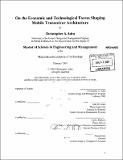| dc.contributor.advisor | John M. Grace. | en_US |
| dc.contributor.author | Aden, Christopher A. (Christopher Allan) | en_US |
| dc.contributor.other | System Design and Management Program. | en_US |
| dc.date.accessioned | 2009-10-01T15:56:35Z | |
| dc.date.available | 2009-10-01T15:56:35Z | |
| dc.date.copyright | 2009 | en_US |
| dc.date.issued | 2009 | en_US |
| dc.identifier.uri | http://hdl.handle.net/1721.1/47872 | |
| dc.description | Thesis (S.M.)--Massachusetts Institute of Technology, System Design and Management Program, 2009. | en_US |
| dc.description | Includes bibliographical references (p. 166-168). | en_US |
| dc.description.abstract | The thesis examines the evolution of mobile transceiver architecture using the management framework pioneered by Carliss Baldwin and Kim Clark. The thesis begins with an introduction and an overview of the wireless communication value network. The author subsequently distills the salient aspects of the Baldwin and Clark management framework predicated on bottleneck analysis, modularity, and return on invested capital. The prominence of bottleneck analysis motivates a technical chapter that summarizes the bottlenecks relevant to all wireless communication systems, namely data rate, error rate, and battery life. A brief chapter discussing the dominant wireless communication network architecture, TDMA and CDMA, corroborates the bottleneck analysis and effectively assigns the error rate and battery life bottlenecks to the handset ODM and supplier layers of the value network. With a clear vision of the competitive bottlenecks, the evolution of transceiver architecture is presented in the context of the aforementioned management framework. Through this analysis, design power is shown to have passed from handset ODMs to integrated circuit suppliers. A noteworthy byproduct of the analysis is the genesis of the bottleneck tree whereby new layers of bottlenecks are emergent upon a firm's selection of a particular design architecture that targets the strategic bottleneck layer. Finally, the thesis is concluded with a summary of the ground covered and the author's opinions of how the architecture may yet evolve and the future nature of the competitive landscape. | en_US |
| dc.description.statementofresponsibility | by Christopher A. Aden. | en_US |
| dc.format.extent | 168 p. | en_US |
| dc.language.iso | eng | en_US |
| dc.publisher | Massachusetts Institute of Technology | en_US |
| dc.rights | M.I.T. theses are protected by
copyright. They may be viewed from this source for any purpose, but
reproduction or distribution in any format is prohibited without written
permission. See provided URL for inquiries about permission. | en_US |
| dc.rights.uri | http://dspace.mit.edu/handle/1721.1/7582 | en_US |
| dc.subject | System Design and Management Program. | en_US |
| dc.title | On the economic and technological forces shaping mobile transceiver architecture | en_US |
| dc.type | Thesis | en_US |
| dc.description.degree | S.M. | en_US |
| dc.contributor.department | System Design and Management Program. | en_US |
| dc.identifier.oclc | 432660881 | en_US |
